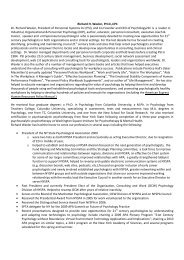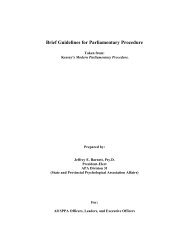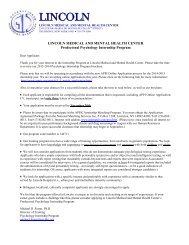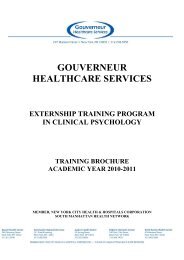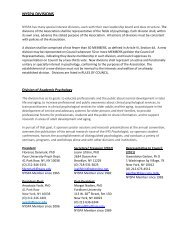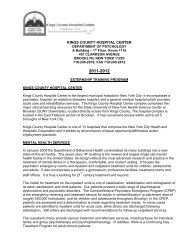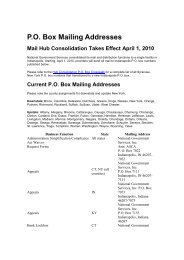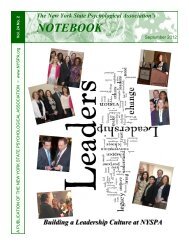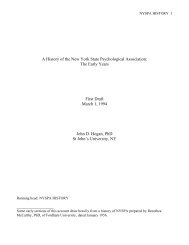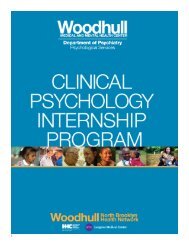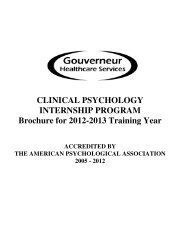2011 ⢠NYS Psychologist - New York State Psychological Association
2011 ⢠NYS Psychologist - New York State Psychological Association
2011 ⢠NYS Psychologist - New York State Psychological Association
You also want an ePaper? Increase the reach of your titles
YUMPU automatically turns print PDFs into web optimized ePapers that Google loves.
They were requested to find a comfortable seated position in<br />
a chair, to keep their spine as straight as possible, and to shake<br />
their hands as if trying to shake a “bug” off their body. Next the<br />
children placed their hands palms up on their knees or thighs.<br />
They closed their eyes and took long, deep breaths, as if they<br />
were blowing out the candles on a birthday cake. They were<br />
asked to feel the breath flowing in their bodies and to observe<br />
how their body was feeling.<br />
After a few minutes the children were guided to focus upon<br />
their hands and to imagine that they were breathing through their<br />
fingertips. They were directed to focus more on the tips of their<br />
fingers as they began to feel the vibration of the breath (prâna)<br />
flowing in and out. As they continued to concentrate on the prâna/<br />
energy flowing into their hands and becoming weightless, the children<br />
were encouraged to allow their hands to slowly float up from<br />
their knees. They were reminded to keep focus on the feelings/<br />
sensations in their hands and their breath as their hands began to<br />
move.<br />
After a few moments the children moved their hands towards<br />
their face. Keeping their hands 1-2 inches away from their face,<br />
they allowed their hands to move gently around their face, head,<br />
and neck, giving their aura a prânic bath. Next the children were<br />
asked to let their hands flow to an area of the body that needed<br />
attention/healing. It was observed that children placed their hands<br />
on their heart, forehead, and even the knees.<br />
At the conclusion of the exercise, children discussed what<br />
accessing prâna felt like for them. They revealed that heat and an<br />
electrical pull were felt in their hands and facial features. Their<br />
sensations varied from scary, weird, jerky, and shaky to sleepy<br />
and calm. Two children were not able to experience the flow of<br />
prâna. One child noticed that prâna did not flow evenly in his body<br />
(Migdow, 1999).<br />
Dinosaur imagery was used because dinosaurs are popular<br />
with children. They learn about dinosaurs in school and through<br />
the media. Dinosaurs’ huge body size, which includes long arms<br />
and legs and large mouth, facial, and torso features fascinate<br />
them. Children like to imitate dinosaurs’ squawking sounds and to<br />
dramatize their fearlessness, especially lumbering through a forest<br />
looking for food to survive.<br />
The guided meditation was selected to provide a safe, enjoyable<br />
opportunity for the children to explore their imagination about<br />
being a dinosaur, and how their body felt after being a dinosaur,<br />
and to stimulate the children’s potential to develop relaxation techniques,<br />
especially under stress.<br />
Outcome<br />
Workshop feedback and observations were used to determine<br />
the outcomes of the workshops. All age groups presented<br />
an increase in awareness about physical and emotional responses<br />
to trauma. Adults expressed better control and the feeling of<br />
resiliency in accepting traumatic events. Children were more<br />
spontaneous after participating in creative expressive and movement<br />
activities (Wiener, 1999).<br />
Conclusion<br />
Yoga therapy can help people of all ages to heal after traumatic<br />
events. It encourages the exploration of thoughts, feelings,<br />
body sensations, and behaviors related to traumatic events in a<br />
safe, supportive environment, recharging and healing the body<br />
and mind and helping to restore it to a condition of harmony and<br />
balance. Thus, Yoga Therapy can thus be an effective stressreducing<br />
technique that provides the individual/s time and structure<br />
for psychological integration and adaptation. Furthermore, I<br />
encourage psychologists to utilized Yoga Therapy to help their<br />
patients deal with symptoms of chronic Post-Traumatic Stress<br />
Disorder (Neria, Y. et al., 2010; DiGrande et al., 2008). In closing,<br />
Yoga Therapy is fitting to be a useful tool for psychologists who<br />
continue to help the survivors of 9/11 and for others suffering from<br />
PSTD, for example our military men and women returning from<br />
Afghanistan and Iraq Wars.<br />
Additional Workshops<br />
Child Study Teams of the Department of Special Education. ( 2002)<br />
<strong>Psychological</strong> First-Aid for Post-Traumatic Stress Reactions: Helping<br />
Children and Teachers Heal. <strong>Psychological</strong> Intervention in the Aftermath<br />
of Trauma. <strong>New</strong> Jersey.<br />
<strong>New</strong> <strong>York</strong> <strong>State</strong> <strong>Psychological</strong> <strong>Association</strong> (2002-2004). Committee<br />
on Disaster Relief.<br />
Seton Hall University, South Orange, NJ (2003). Psychology and Spirituality.<br />
University of Dentistry and Medicine. (2002, Winter). Healing and<br />
Recovery after Trauma—Project Hart. Led groups of children and<br />
families in the county of Hudson in the communities of Bayonne, Hoboken,<br />
and Jersey City.<br />
REFERENCE<br />
Adams, R. E., & Boscarino, J. A. (2006). Predictors of PTSD and delayed<br />
PTSD after disaster: The impact of exposure and psychosocial resources.<br />
Journal of Nervous and Mental Disease, 194, 485 – 493.<br />
Agronic, G., Stueve, A., Vargo, S., & O’Donnell, L. (2007). <strong>New</strong> <strong>York</strong> City<br />
young adults’ psychological reactions to 9/11: findings from the reach<br />
for health longitudinal study. Journal of the American Academy of<br />
Child and Adolescent Psychiatry, 39, 79-90.<br />
American Psychiatric <strong>Association</strong>. (1994). Diagnostic and statistical manual<br />
of mental disorders (4 th ed.). Washington, D.C: Author.<br />
Brown, R., & Gerbarg, P. (2005). Sudarshan Kriya yoga breathing in the<br />
treatment of stress, anxiety, and depression: Part II – clinical applications<br />
and guidelines. The Journal of Alternative and Complementary<br />
Medicine, 4, 711-717.<br />
Citizens’ Committee for Children of <strong>New</strong> <strong>York</strong>, Inc. (2002). Children and<br />
Crisis: NYC’s Response After 9/11. <strong>New</strong> <strong>York</strong>: Belden Russonello &<br />
Stewart.<br />
Chen, H., Chung, H., Chen, T., & Fang, L. (2003). The emotional distress<br />
in a community after the terrorist attack on the World Trade Center.<br />
Community Mental Health Journal, 39, 157-165.<br />
Clampett, C., & Peal, A. (2000). Therapeutic yoga training manual. Santa<br />
Barbara, CA.<br />
Cohen, J. A., Berlinger L., & March J. S. (2000). Treatment of children and<br />
adolescents. In E. B. Foa, T. M. Keane, & M. J. Friedman (Eds.),<br />
Effective Treatments for PTSD: Practice Guidelines from the International<br />
Society for Traumatic Stress Studies. <strong>New</strong> <strong>York</strong>: Guildford.<br />
DiGrande, L., Perrin, M., & Thorpe, L. (2008). Posttraumatic stress symptoms,<br />
PTSD, and risk factors among lower Manhattan residents 2-3<br />
Years after the September 11, 2001 terrorist attacks. Journal of Traumatic<br />
Stress, 3, 264-273.<br />
Epstein, M. (1998). Going to Pieces without Falling Apart. <strong>New</strong> <strong>York</strong>:<br />
Broadway Books.<br />
Galea, S., Resnick, H., & Ahern J. (2002). Mental health needs in <strong>New</strong><br />
<strong>York</strong> <strong>State</strong> following the September 11 th attacks. Journal of Consulting<br />
& Clinical Psychology, 79, 322-331.<br />
Laraque, D., Boscarino, J., & Battista, A. (2004). Reactions and needs of<br />
Tristate-area pediatricians after the events of September 11 th : implications<br />
for children’s mental health services. Pediatrics, 113, 1357-<br />
1366.<br />
Le Page, J. (1994). Integrative yoga therapy manual. Santa Barbara, Calif.:<br />
Joseph Le Page.<br />
McCormick, M. (1995). Family issues and outcomes of adjustment to spinal<br />
cord injury. Unpublished doctoral dissertation, Seton Hall University,<br />
NJ.<br />
Page 3<br />
Vol. XXIII No. 2 • Fall <strong>2011</strong> • <strong>NYS</strong> <strong>Psychologist</strong>



